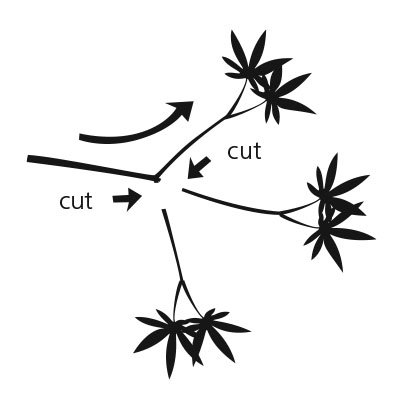Pruning WEEPING Japanese MapleS
Pruning the beautiful and delicate-looking weeping (or “laceleaf”) Japanese maples (Acer palmatum var. dissectum & cultivars) may seem intimidating at first. The principles of thinning and layering are a similar approach as with upright ornamental trees. But there are some key differences:
Weeping - on weeping trees, it can be a challenge to layer branches and foliage the way we do with upright, horizontal branching trees. Prune to manage and enhance their “waterfall” character.
Contorted branching - their twisting habit can make it a challenge to determine branching hierarchy.
Dense branching & foliage - weeping Japanese maples tend to grow quite dense, especially if planted in full sun. Thinning them may be recommended once or twice a year.
Spreading - most weeping varieties are considered dwarf in height but spread wide. If planted too close to a walkway, wall or other plant, they may need more frequent pruning to redirect growth and minimize conflicts.
WHY PRUNE WEEPING JAPANESE MAPLES?
Redirect growth energy to a desired direction. Reveal beauty of branching patterns by selective thinning. Allow greater light penetration and air circulation. Reduce risk of wind and snow breakage.
WHEN TO PRUNE THEM?
Early winter - any time between total leaf fall and the breaking open of the first spring buds. Good for major clean-out and thinning. Too much pruning may overstimulate new growth. Watch for excessive running sap on warmer days.
Summer - after leaves are full size, through early September. Good to see foliage masses for thinning and layering. Easier to identify dead branches. Generally stimulates growth less than winter pruning.
HOW MUCH TO REMOVE?
Do less then you think you need to. Best to prune gradually over time. Try to not remove more than 1/4 of the volume of the living branches in any one year. Dead branches can be removed anytime.
3 BASIC STEPS
Clean Out - Remove branches which are dead, diseased, broken, or out of character with the rest of the tree. Unlike most trees, you may leave some crossing branches (touching on each other).
Thin - Most densely-branched areas first. Open up light and air circulation. Make the interior more open but not hollowed out or sparse. Balance the branch density around the tree..
Layer - On more horizontal branching trees — thin more to enhance foliage “clouds” and spaces between them. On more vertical growers — lightly thin between major branch groups. Enhance the staggered “waterfall” pattern between branch groups. Open up views of attractive/ unique branches & structure (such as at major crotches)
TOOLS
Hand pruner, “fruit” or “floral” pruner (narrow blades), lopper, folding hand saw (very small bonsai saw can be useful). Sharp tools = better for clean cuts, less stress on your hands.
MISCELLANEOUS WISDOM
Don’t fight your tree’s will to grow to a certain size. Accommodate it, or replace it with something smaller.
Safety! Eye protection from branches.
Work from inside out, bottom to top.
Start by thinning out smaller inside branches. Work up to larger branches if necessary. Before cutting a large branch, try to shake or trace it to anticipate the effect of its removal.
Leave minimal length of a branch stub, but don’t cut flush against the parent branch.
Work around the plant at least twice (if possible). You will notice different details each time.
THINNING METHODS for WEEPING JAPANESE MAPLES:
Redirecting - Think of “growth energy” as moving through a healthy tree like water through pipes. Restricting it by too-frequent heading back can cause aggressive sprouting. Try to redirect branches’ natural flow away from areas of crowding or conflict, and toward where they can thrive.
Thinning cut - removes an entire branch, rather than a heading cut which shortens the branch (inducing more density).
Half-Diameter Principle - when removing a branch, try to redirect to a side branch at least 1/2 the diameter of the branch you’re cutting.
Work from the inside out - bottom to top, smaller branches to larger. This typically gives a more natural-looking result and helps you decide which larger branches to cut, if necessary. Avoid over-thinning. Make it more “transparent” or “breathable” but not sparse.
Balancing branch density - after you’ve thinned one area, work to thin the other areas to a similar density.
Layering - you can try additional thinning to create more vertical and horizontal separation between branch groups, enhancing their natural “waterfall” effect.







